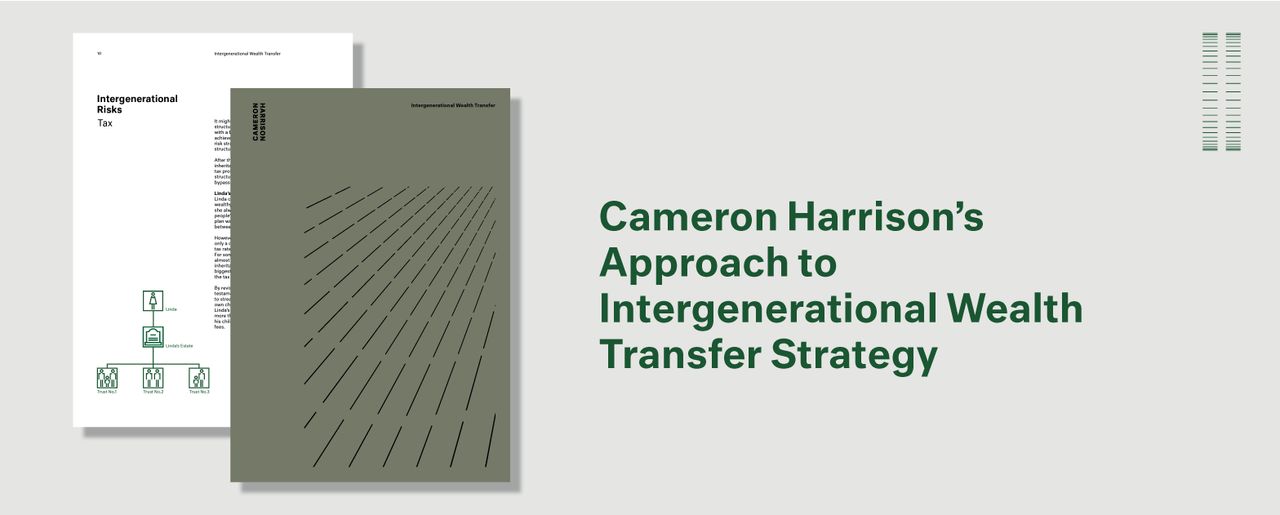The Intergenerational Wealth Transfer Strategy of your wealth (which could be owned or controlled) is a necessary consideration in the context of your vision, legacy, enterprise, family, provision for beneficiaries and philanthropic intentions. Once the context is clear – which may take some time and iteration – the objective is then to design and document the method by which one ensures control and ownership of assets is transmitted to the desired future users or beneficiaries. It can appear a daunting exercise, and indeed it can be. To be done effectively, people are required to express their thinking across all aspects of their life, their reasons for doing as they do, and their views, attitudes and wants for both their future and beyond their lifetime.

Over the last twenty years, business owners and family investors have accumulated significant wealth. Over this period, there has also been continued social change seeing challenges across increasing life expectancy, divorce, second families, relationship definition changes, desires to assist adult children during one’s lifetime, poor housing affordability and private education demands. More than ever, it is vital to have a carefully well thought-out Intergenerational Wealth Transfer Strategy that brings together and prioritises your issues. Such a plan keeps you ahead of life’s curve and the often-unpredictable events that can occur. The alternative is invariably costly bedlam and trauma for survivors and future generations.
People rarely intend not to have plans properly in place, but because they have put it off, have a mental plan but not documented it, failed to regularly review their plan for circumstance changes or they have received poor or inadequate advice, some very unfortunate and unintended consequences arise. This can take both a financial and emotional toll on families.
Our Partners have witnessed many things over 50 years, but a few examples of common traps and areas of hurt are:
Comprehensive Planning Pitfalls
Lack of integration between purpose and mission with tax, asset protection and economic strategy: Where clients seek disparate advice rather than a coordinated planning expert, uncoordinated outcomes result. A failure to bring together objectives and purpose with the specific technical elements (tax, asset protection, business and private wealth strategy) leads to gaps, further amplified by a lack of reflection and iteration.
Failure to walk-through the practical application of plans and documentation: Where documentation (Wills, deeds and other documents) is not tested through a scenario analysis to see whether they operate as intended. Often this can be because of template legal precedents used by lawyers and/or a failure to contemplate and integrate tax, transaction sequencing, asset protection, funding, distribution and so on.
No Business Succession Plan: Succession of control, ownership and management of a business is a fundamental risk management requirement for business owners. The very real risk of a sudden change in circumstances due to health, death, new relationship and children of new partners necessitate proper consideration ahead of time.
Lack of understanding of complex plan arrangements: The legal, tax, commercial and documentary complexity involved can mean the understanding of what arrangements and strategy you have in place is difficult to recall later in time. Having a plain English summary of these complex arrangements ensures you are able to regularly review the relevance and currency of your plans.
Incapacity or diminished capacity: Where not pre-envisaged with arrangements and alternative appointments, existing trusts and companies can become paralysed when a loss of capacity renders a person unable to act on their affairs or existing structure. Even worse, personal financial, lifestyle and medical arrangements become subject to formal orders which might be completely contrary to your desired care, succession and intergenerational plans.
Forgotten Fundamentals of Estate Planning
No Will: A high earning professional with a wife and young children suddenly dies from cancer and does not have a Will. He leaves debts, no insurance, modest equity in a home and holiday house and private school education commitments. Sudden death at a relatively early age is difficult enough, but dealing with a field of land mines like this is overwhelming.
Will is not stored safely : Copies of the Will are with advisers but the original cannot be located. Proving the Will through probate and with competing claims on the Estate assets means an expensive process of sworn affidavits and court applications. Imagine a potential beneficiary withholds or destroys the original Will – a criminal act. Can the appointed Executor act? Do representation orders need to be sought?
Body and funeral: Where there is conflict between the Executor and others claiming the body and remembrance rights, the Coroners Court or Supreme Court may need to resolve.
Control of Testamentary Trusts: Trustee succession is addressed but the Appointor roles are inconsistent and the Appointor acts to remove the Trustee.
Named parties are no longer appropriate: Whether it is Executors, Trustees or Appointors, the people nominated back in time are now inappropriate. That once trusted business partner and friend is now neither, but estate plans and documents have not been reconsidered or updated.
Circuit breaker mechanism where conflict exists: Often there will be conflict in decision making and dispute resolution arrangements need to be in place to resolve with due consideration of equity issues while also mitigating legal and judicial expense. A poor outcome is an impasse that involves significant legal expense (and unnecessary dissipation of assets).
Testamentary Trust beneficiaries: Wills drafted some time ago may contemplate a class of beneficiary such as ‘spouse’ who was intended to be a married spouse, but in today’s terms, that definition may mean de facto, a partner etc. Clarity is key, otherwise claims can be made and desired asset protection objectives are not achieved.
Succession of roles: To consider how roles such as Trustee and Appointor will succeed to the next generation. Often there can be undesirable entrenchment of people which frustrate the ongoing purpose of the intergenerational aspirations.
Vesting: Existing inter vivos trusts are inadvertently vested giving rise to both an undesirable CGT event and asset protection position moving forward.
Capacity: The increasing prevalence of Alzheimer’s and Dementia, which is often not diagnosed in the first three years or so, impairs an individual’s judgements, making them prone to poor decision-making and/or subject to undue influence or elder abuse.
Statement of Wishes: A document which tends not to be binding and may or may not be contained in a Will, can be useful to bring the thought and intention behind the strategy to life. Without a Statement of Wishes to guide the Trustees, Appointors and perhaps beneficiaries, the strategy is only apparent to the deceased or previous generations, leaving the current and future generations to operate in a contextual vacuum.
Cameron Harrison have been advising business owners and their families on asset allocation and intergenerational wealth management for over 50 years. We have demonstrated over a long period our ability to manage investments through both the good times and bad by keeping the client at the centre of our business.
For more information on our approach to private wealth management, please contact us on +61 3 9655 5000.
